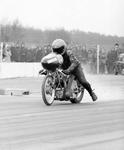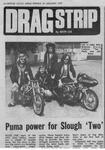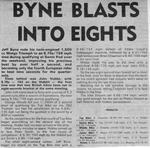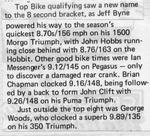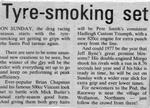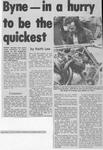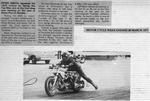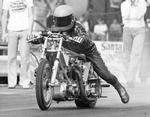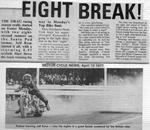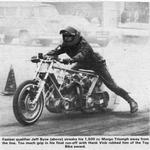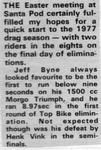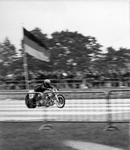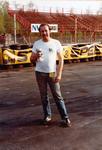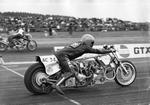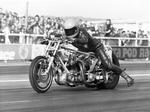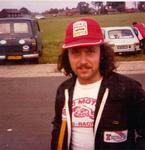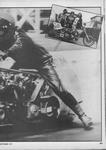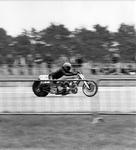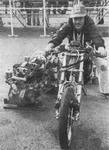
As told exclusively to Jeff Byne first attended Santa Pod as a teenager but before he was 20 years old bought a racing bike and made his competition debut at Santa Pod in August 1970, followed by sprints at Duxford Airfield in 1970 and 1971. Continuing his career at Santa Pod, Jeff bought a frame from Ray Feltell for 1973. A turning point in his career was a football pools win at the end of 1974 which enabled him to build a new, twin Puma Triumph bike during 1975. In its first year, he ran his first eight and became competitive in Top Bike against riders such as John Hobbs and Henk Vink, winning the Jubilee Big Go event in 1977 and travelling to Holland and Sweden to compete. I was born on 23th December 1950 in Slough at Upton hospital and have lived in Slough all my life. I went to an old Victorian primary school within yards of where I lived. Secondary school was Churchmead in Datchet,I Left at the age of 15 as I didn't want to take any exams because all my friends were going to work. I got a 5yr apprenticeship with the North Thames Gas Board as a gas fitter as we were called in those days. The gas works were less than a 10 minute walk from where I lived. The first time I went to watch drag racing was with a couple of guys from work; we went to Santa Pod (there’s a poster on the garage wall) when the Commuter dragster did its quickest run so far, which was an 8.2, I remember the time which has stuck in my mind. Big Daddy Tony Densham was the driver, as they called him. The next time was on my 650 BSA motorcycle. When I was young my dad had a BSA Bantam as the family transport, then a 650 Triumph Thunderbird sidecar outfit, my Mum on the back and my sister and I in the sidecar. This must be where my interest in motorcycles came from. Then he passed his car test and got a Standard 8 saloon car. We used to ride bikes over the fields when I was 14, me and my mate Bob Webster who had an old 175cc BSA Bantam. His family had a printing company and his Mum would take us in the company Vauxhall Viva van with the bike to the fields - this would be 1964/65. Another mate had an Aerial 500cc single, several others had various motorcycles, making a nuisance of ourselves, I'm sure, around this bit of waste land. Then she’d come and pick us up and take the bike and us home. I was interested in motorbikes from 14 years old and as soon as I was 16 got a motorbike on the road, a little BSA C15 250, and started going to the local motorcycle cafe in Windsor called the Cellar, which was quite famous or infamous at the time with bikers. It was by the river Thames at Windsor next to Eton Bridge. Before I had a bike we used to walk over there in the evenings just to look at the bikes as I was not old enough to have one then. I progressed from the C15 to a 650 BSA A10, During that period I met loads of people who had bikes and then everyone went their separate ways. I gave up road bikes in the early 70's. Around that time I was going to a pub in Shepperton, the Kings Head. This guy came in and said hello to me, I kind of didn’t recognise him but we worked out that we'd met in the Cellar some time before. During our conversation he asked if I was interested in buying a sprint bike, a 650 unblown Triumph. I said "No, not really", and that was that, this was early 1970.
A couple of months or so later the same guy, Roger Pailes, came into the pub chatting away again and he’d obviously forgotten what he said previously about his bike, and again asked if I was interested in buying a Sprint bike? This time I said "I don’t know, maybe I am." He explained it was a Triumph 650 Bonneville engine, unblown with Twin Amal GP carburettors and BSA gearbox. I think it was £100.00 he wanted for it. At the time I didn’t have a bike or car license but you didn't need a bike license to race in those days because the meetings were closed to clubs. We agreed I’d meet him one evening on a semi unused bit of road in Chobham on the way to the Bovington Tank Museum. They got the bike out the back of their van; Bob Webster and I went. They poured in some methanol and to me then that was exotic, this thing doesn't even use petrol. We pushed him up the road and he shot off, turned round and came back. He said "Right, do you want a go." "Yeah right I suppose so" I said, so I sat on it and gave it a little squirt up the road and back, and the deal was done. Bob Webster started to race a bike soon after I started drag racing. We were in his company Viva van so we bundled the bike in the back. I was now the proud owner of a sprint bike and home we went. £100 changed hands, which was a reasonable sum in 1970 as I was probably earning £25, £30 a week after I had finished my apprenticeship. I joined the NSA, The National Sprint Association; I could still go sprinting on the bike 40+ years later at a Dragstalgia meeting. Not so long back, Roger Pailes came and introduced himself to me. He said "I can still see a couple of bits of my old bike there". I said "Yes, that brake lever and the front cylinder head that’s all that’s left from your bike". Looking at my pieces of paper, it would appear I’d forgotten I went to Santa Pod 23rd August 1970, my first outing on the bike which I always thought had been a sprint at Duxford. At Santa Pod, I must have met Roger and his mate Brian Milling who gave me a little insight in what to do with the bike and how to run it. According to this piece of paper it was run on methanol and my very first run was a 13.91 at 106.04 mph. I did four runs that day. The 3rd run was the quickest at 12.78, 105.8 mph then slower on the fourth run because I missed a gear. I rode the bike as I bought it, as I knew nothing about what to do. I just bought a 5 gallon drum of methanol from a shop in Twickenham which ran grass track bikes and was ready to go. Then the meeting that I thought was my first meeting was at Duxford, 4th October 1970, It appears I did 5 runs that day, 1st run was 13.22; they didn’t have speeds then at NSA sprints. My final run was 12.23 being my quickest run so far. During the winter of 1970/71 I took the bike apart and got the frame stove enamelled and tidied it up because it was pretty tatty hand painted silver, and I also fitted a slick on the back wheel. When I bought it, it was fitted with a 16" diameter treaded sidecar racing tyre, there were no slicks in road racing at that time, so I bought two 16" dia. slicks, one unused the other part used, from Clive Waye of Dragwaye fame. He had them specially made as 16" diameter slicks did not exist and caused some puzzled looks in the pits. During 1971 I ran in the 12’s then into the 11 seconds bracket; I think the best was 11.5 or 11.6. By then I was putting a bit of nitro in it. In September 1971 I got my picture on the front of Motor Cycle, I think purely because I was wearing a Bell helmet, very expensive for their day at £35.00 and almost nobody had one. I think that was the only reason and there weren't many people wearing them even in road racing even back then. Towards the end of that year, Ray Feltell had a bike called Penetration which was the quickest bike around at the time and he got down to 9.6, 9.7 in 1972. He was going to have a new frame for the following year, 1973. His frame was an old Alf Hagon frame with a single top tube which doubled as the oil tank. I agreed I’d have his rolling chassis at the end of the year. In September/October he was going to try and set records and we went up to help him, I don’t remember how well he did.
Ray gave me some tips on how to set my old engine up and fit a supercharger, lower compression, different ignition and valve timing etc, to use in his old rolling chassis which came with engine and blower mounting plates. That bike was built over that winter for the 1973 season. It had a Norton gearbox and AMC clutch, a Shorrock C75B vane type supercharger and my old 650cc Triumph engine. Ray made some comments a few years later when I was going pretty well, probably 1974. He was asked by another racer, "Did you sell Jeff the engine with the bike?" He said, "No, but I may as well have done". I was going quicker than he did before and this was in part due to the information he gave me about setting the valve timing etc. We were reasonably successful in 1973 and 1974. During the '74 season I won more races and meetings than I lost. We were running up to 80% nitro by the end of 1974, also adding Propylene Oxide which used to frighten the living daylights out of Peter Billinton of G Max Racing Fuels. When pouring it, you could only have it in a steel can which had to be earthed because it had such a low flash point, just the slightest spark was needed to ignite it. I only ever bought one gallon and I don’t know if it’s still used today. We used 80% nitro, 20% methanol and a pint of propylene oxide. It was an ignition accelerator basically.
I blew it up a few times, once at Silverstone when the engine top end came up and bent the frame top tube like a banana. It was a single 2 ½ inch tube which held the oil; John Clift made up a new tube and welded it in. I’d just blown up my best engine and I was going to have a go at records soon after. I put an engine together with two big lumpy camshafts and fiddled about with the timing on them. To be honest, it was too quick for the frame that I was using and I couldn't keep the front wheel down. We went to Elvington and wheelied everywhere; a friend of mine got a picture of me burning out against my old van at that meeting, unfortunately I don't have a copy. So I didn’t set the world record or anything like it. This was the end of '74. I did win the BDR&HRA championship that year though. All my cups and trophies are in a tea chest in the loft. I’ve moved houses a few times and they haven’t reappeared. When I was still running, they were all out in the living room on display.
By then, Pete Davis was manufacturing Puma crankcases for Triumphs. We got to know Pete as he rebuilt our superchargers, on which he did a very good job. Because I used to run the blower too fast, the first few runs the vanes scraped the casing and would foul up the spark plugs with aluminium dust, once it got some proper clearance again, which undid all the work Pete had done, I could do a proper run without fouling the plugs. They were Shorrock vane type superchargers and the drum is only supported at one end so it flexes. I used to rev the engine to 8000 rpm and the blower was running at one and a quarter times engine speed, so it was running much too quickly. I think its design limit was 6000 rpm or so. The blower was probably doing 9000+ rpm and creating the aluminium dust which then fused to the hot spark plugs. Once the blower was worn, then it wouldn't foul the spark plugs anymore. We used an Avon 18” inch diameter slick by 4” wide as did most racers at that time, then M&H came on the scene with a 4” wide slick, which was a much more sticky compound, most people switched to them. M&H made an even stickier compound, I tried one and only got one run on the £100 slick because the chain broke and slashed the wall of the tyre; luckily it didn't deflate, but was ruined - I was obviously a little bit pissed off. On another occasion, I snapped a rear wheel spindle on the 750 in, I think, 1972 and skated through the top end with a locked up back wheel and came to a stop without crashing; I borrowed another rear wheel and came out for the next round and won. The plan for the following year, 1975, was to have a set of Puma crankcases, a six and half inch slick which the Americans were using and were starting to be used here, and a new longer wheelbase frame. I had previously extended the old Hagon frame by another 3 or 4 inches, but it still used to wheelie its way up the strip. In fact one of the articles in a Motorcycle newspaper said, I spent more time on the back wheel only than on both wheels. So that was the plan, then I won £3,183 on the football pools just before my 24th birthday, December 1974. You could buy a house then with that amount of money. My Mum had kittens because it came in the post in a registered envelope; back in those days the amount of postage was something to do with the value inside which was a cheque for that amount. So that made me decide instead of building a single engined bike, I’d build a double engined bike as now I could afford it. It took me all through the winter and the following year. So two sets of Puma crankcases and Puma slider clutch were ordered; I used 750cc Norton Atlas crankshafts which gave a bigger capacity when combined with Morgo 750 cc barrels. This conversion gave 820cc, so 1640cc in total. Derek Chinn machined up the Ray Baskerville cast gear case castings for the Ariel Square Four gears linking the two engines and made billet flywheels to replace the standard Norton cast iron ones which were not strong enough. All for the princely sum of £90. I bolted it together with aircraft quality bolts. John Clift built the frame using 4130 chrome moly tube, a 6 ½ inch Cragar 2 piece lightweight back wheel with M&H slick and a Lenco 2 speed gearbox from America, which cost around £400 and was imported by Dave Johnson, who also went on to build a double engined bike. Back then, the exchange rate I remember well was $2.34 to the pound. A set of 250 Suzuki GT front forks, wheel hub and single disc brake was used up front, a lightweight Hurst Airheart American brake calliper and disc used as the rear brake, they weighed nothing but didn’t work so I scrapped them as the disc would warp with the heat; it was only an ⅛ inch thick, although I drilled holes in it and it still warped. I got another brake disc off a Japanese bike from a scrapyard and used that with a Lockheed racing calliper - problem solved.
I fitted two Shorrock C142B 1340 cc superchargers one per engine which I ran at engine speed, once again more than they were supposed to be run at. The bike was built in a wood and asbestos garage at my parents house, no fancy heated workshops back then, just a mile from where I live now. In fact my race bikes were assembled over the winters in the house, the 750 in my upstairs bedroom and bounced downstairs one step at a time, not helped by the staircase having two 90 degree turns. The double would be assembled in the hallway; the first thing visitors would see when the front door was opened was an 8" slick staring them in the face. Thankfully, my parents were fully supportive of my racing and came to a lot of meetings. Over the period of 1975, the bike was slowly getting built. During that time, I rode Don East’s 650 Triumph two or three times and blew it to pieces; he’d stopped racing at that time. Triumph engines used to blow to bits if you misbehaved with them. I kept the engine out of my single engine bike and sold the chassis to who I believe was Ray Simpson.
My first meeting with the twin engined bike was early 1976 at Snetterton. I used methanol only for the first few runs. Then we went to Santa Pod and had various trials and tribulations with the new bike. The fancy American gearbox had a fundamental flaw. After a while a circlip in the gearbox would pop off every time I pulled in the clutch lever. The shaft moved over and that was the end of that. So I rebuilt it and fitted an ⅛ in spacer to take up the end float, and a friend of mine who had an engineering shop cut a thread on the end of the mainshaft by fitting a nut on the end of the gearbox shaft which was outboard of the main bearing - the problem was cured. It was possibly the fact that I was using a hydraulically operated clutch instead of Crower style. centrifugal clutch. I only fitted a purely centrifugal slider clutch in my last year of racing. We ran it through 1976 (the times and speeds are in the photos of the newspaper cuttings). The fuel system was gravity fed using a 2 inch SU carburettor per engine. I started to get fuel starvation on the front engine because of the carburettor position. I’d turned the carburettor to face backwards instead of forwards so the fuel flowed slightly differently. I immediately ran my first 8 second run at 8.70 at 156.95 mph on 16th October 1976 and this was the quickest bike run in Europe that year. In April or May 1977 I went with John Hobbs to Sweden to do 1/8th mile match racing. The Pegasus team were due to go but broke their bike at the Easter meeting and I was asked to go instead. One thing I’ve never really understood, and I’ve not discussed it with John, but it was the best of 3 match races over the ⅛ mile. I’m fairly clear in my mind that I won 2 and he won 1. Because I took longer in getting back for some reason, he got given the winners cup and I got the runner up. We’d checked out of the hotel the next morning and were going to Gothenburg to catch the ferry but when we got to the docks the gates were locked and I couldn't see a boat. John was in front of us as he had all the tickets; he walked back to us and said "The ferry is tomorrow, I've made a mistake". Our friend John Harpem, lived in Sweden at the time so we went to visit him and the four of us ended up sharing a bed that night. There was me and my wife on one side, John and his wife on the other side, also their young son, all sharing the same bed. Duxford Sprint results 12th September 1970: Page 1 Page 2 Page 3
Gallery: click on any thumbnail for a large image.
Back to pioneers index Back to News page |




























